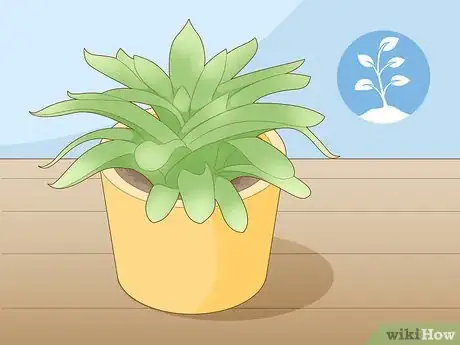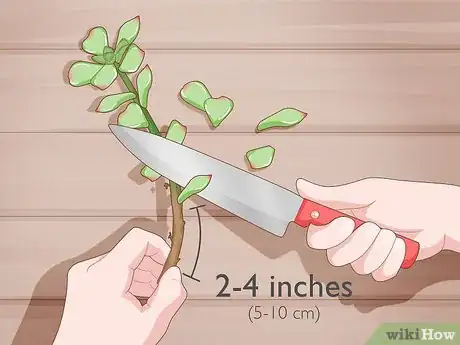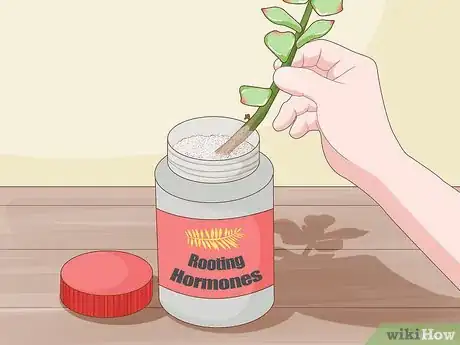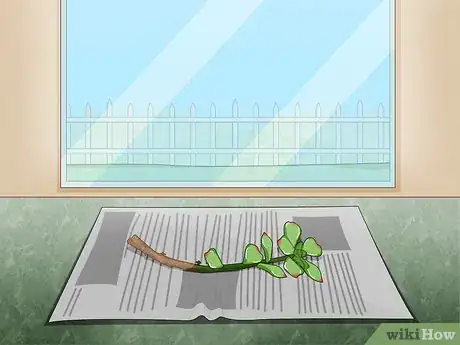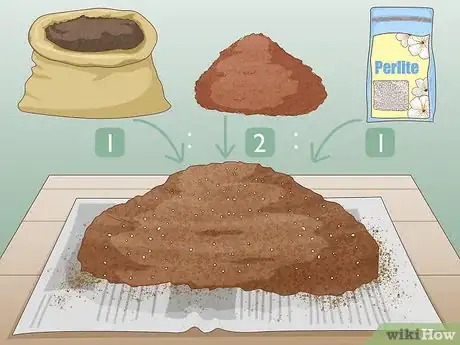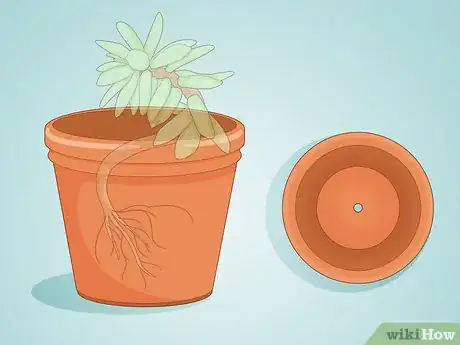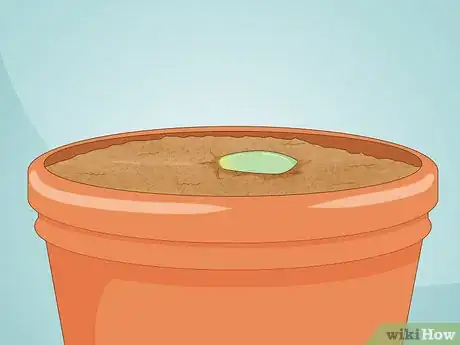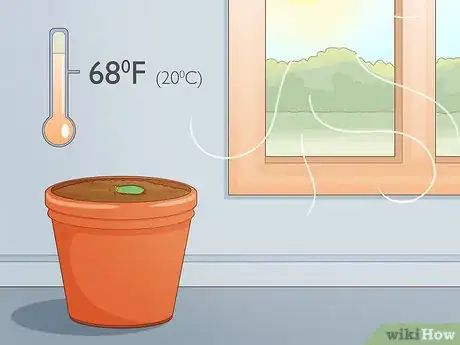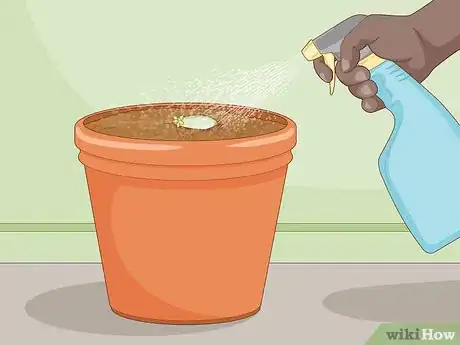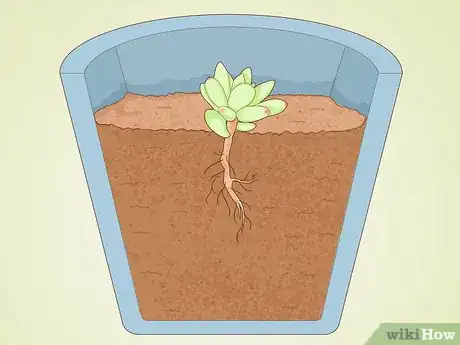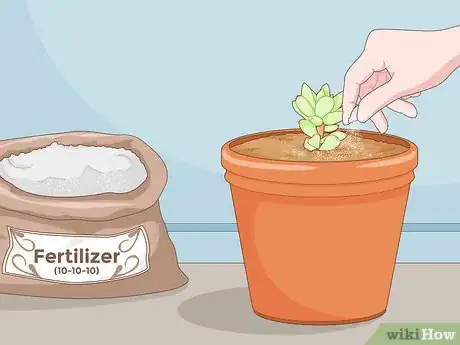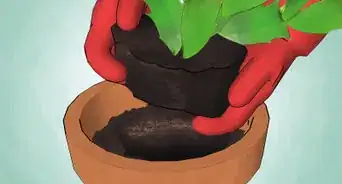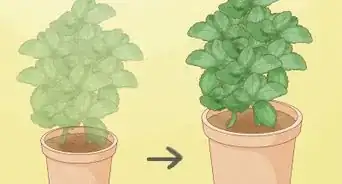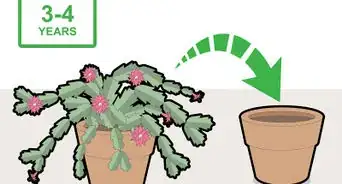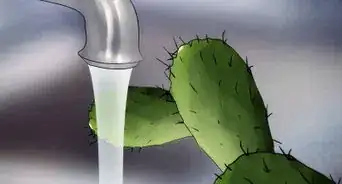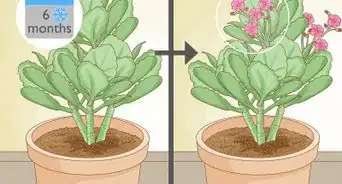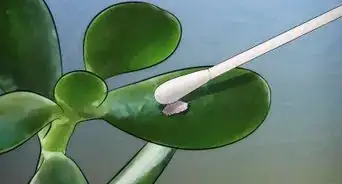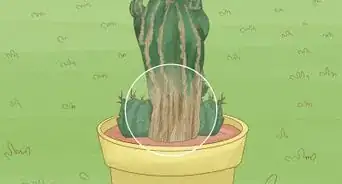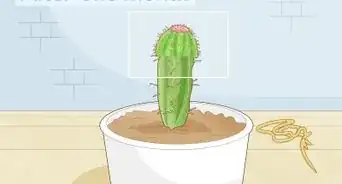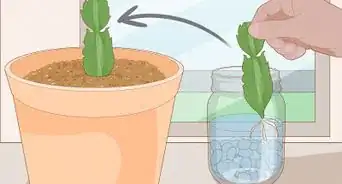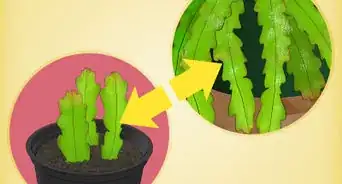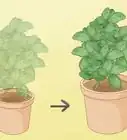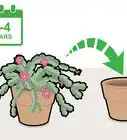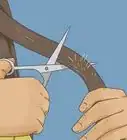This article was co-authored by Chai Saechao. Chai Saechao is the Founder and Owner of Plant Therapy, an indoor-plant store founded in 2018 based in San Francisco, California. As a self-described plant doctor, he believes in the therapeutic power of plants, hoping to keep sharing his love of plants with anyone willing to listen and learn.
There are 12 references cited in this article, which can be found at the bottom of the page.
wikiHow marks an article as reader-approved once it receives enough positive feedback. This article received 30 testimonials and 92% of readers who voted found it helpful, earning it our reader-approved status.
This article has been viewed 525,393 times.
Most succulent plants are easy to propagate, and have plenty of leaves for you to try out a large batch at once with little effort. You can even propagate succulents from a single leaf, although some species require a proper stem cutting.
Note that aloe plants require a different approach for best results.
Steps
Taking Succulent Cuttings
-
1Begin at the start of the growing season. You may attempt to propagate succulents at any time of year. However, you may have the highest chance of success if you start near the end of the plant's dormant period, or at the start of the growing season.[1] In most cases, this means early spring, but a few succulent species begin growing in autumn or winter.[2]
- If you already have a succulent cutting, skip to the next section, on planting the cutting. Even if you did not follow the steps below to remove the cutting, most succulents still have a relatively high chance of propagating.
-
2Sterilize a sharp knife. Select a razor blade or sharp knife, capable of making a straight cut through the plant. Reduce the risk of infection by heating the knife blade in an open flame, or by wiping the blade with rubbing alcohol.Advertisement
-
3Decide whether to cut individual leaves or a larger cutting. Most succulents can grow a new plant either from an individual leaf or a stem segment. However, some genera such as Dudleya or Aeonium require a stem segment.[5] [6] Refer to the steps below for more information.
- If you do not know what genus or species your succulent plant is, try either method. The mother plant is unlikely to suffer if you follow the instructions below, making this a low-cost experiment.
- For a few unusual genera, but notably with aloe plants, the plant is best propagated by removing a newly grown "pup".
-
4Select a leaf to cut. If your succulent has a "rosette" of tightly circled leaves at the top of a stem, leave that untouched and cut leaves from lower down, but not directly at the base of the plant.[7] For succulents that mostly grow outward, rather than upward, cut the leaves from the outer edge. Cut leaves where they connect to the stem, making a straight cut.
- Unless you are also taking a stem cutting, skip ahead to the section on planting your cutting.
- See the Tips section if you have a succulent with very large leaves.
-
5Select a stem to cut. Most succulents are not difficult to grow, but you can still increase your chances of a healthy plant with the right cutting. Ideally, select a stem that is actively growing, near the top or outer edge of the plant, and 4–6 inches (10–15 centimeters) long.[8] Cut directly beneath a stem joint, or beneath the point where a leaf or bud joins the stem.[9] Choose a piece with at least two leaves (or clusters of leaves), if possible.[10]
Preparing and Planting Succulent Cuttings
-
1Strip leaves from the lower part of the stem. If you are using a stem cutting, remove the lowest cluster of leaves. Strip them with the same, sterilized knife, leaving the lowest 2–4 inches (5–10 cm) of the stem bare. Don't remove remaining leaves higher up on the stem cutting.
- If buds are on your cutting, leave them on.[11]
-
2Dip the cut end in a rooting hormone (optional). Commercial rooting hormone powder may hasten the development of the cutting, and often includes an antifungal agent as well to prevent rot. This treatment is recommended for rotting cuttings and for older, "woody" stem cuttings, but is typically not necessary otherwise.[12]
- Some gardeners report success using ground cinnamon as a cheaper alternative to antifungal treatment, sprinkling it onto the cut end.
-
3Let the cutting dry out in a lightly shaded location. Keep the cutting on a paper towel away from direct sunlight, and check on the cut end regularly. The cut should dry out, making the new plant less susceptible to rot. Stem cuttings can be planted after one or two days of drying.[13] Leaf cuttings undergo a more visible change, growing a "callous" over the cut surface. This can take anywhere from two to seven days.[14]
- If a leaf shrivels significantly during this time, you may need to plant it early. This has a lower success rate, but the leaf may die if it dries out completely.
-
4Prepare a succulent potting mix. While waiting for the cuttings to dry, fill a small pot with a fast-draining succulent or cactus potting mix. If you wish to make your own, mix together three parts potting soil, two parts sand, and one part perlite.[15]
- Use coarse, salt-free, store-bought sand if possible, since hand-gathered sand may contain microorganisms or salts that could harm plants.
-
5Select an appropriately sized pot to plant your cutting. Succulent plants thrive in pots that aren't too much bigger than the plant itself. Pots that allow for about an inch or two of growing room should be fine while the cutting is getting started.
- The pot must have a drainage hole.
-
6Plant the cutting. Stems cuttings can be planted as usual, burying the stem until the lowest leaves are just above the soil, but not touching it.[16] Buried leaves are more likely to rot, so if you have a leaf cutting, try just touching the cut end to the soil surface, propping the leaf up with pebbles.
-
7Water occasionally. Succulents don’t need a lot of water, in general. Still, you’ll need to water cuttings every 2 to 3 days or so while they establish roots. Once the plants have started to build a root system, you can cut down to weekly watering or whenever the soil is dry.[17]
- Don’t be worried if the cuttings look like they’re drying out, at first. This means the plant is using its stored energy while it puts down new roots.
- If things work, you should start to see new growth in about 4 weeks.
Caring for Young Succulents
-
1Place the plant in a warm, airy location. Young succulents may not have the water supply to withstand direct sunlight, unlike adult plants. They do best in indirect sunlight, temperatures of around 68ºF (20ºC), and in locations with good air flow.[18]
- Many succulents actually do better in indirect light, even after they’re well established.[19]
-
2Keep the soil slightly moist. Young succulent cuttings need a regular supply of water in order to stay alive and develop roots. However, succulents are adapted to dry climates and will usually rot if kept in soaking conditions.[20] Try using a spray bottle or small pitcher to add water to the top of the soil as soon as it dries out, about every two or three days.[21] Mist your leaf cutting directly as well, since it has not yet developed roots.
- If your tap water is heavily chlorinated, or if your cuttings develop rot, try using distilled water.[22]
-
3Reduce watering as the plant develops. A stem cutting may have a sufficient root system after four weeks, at which point you may water as infrequently as once a month.[23] Leaf cuttings will develop more slowly, but can also be tracked by eye as small leaves and roots emerge from the cut end. Reduce watering frequency gradually once the roots enter the soil, which may take six weeks or longer.
-
4Use fertilizer cautiously. Succulents are slow-growing plants, and are not adapted to growing in high-nutrient soil.[24] Use a balanced fertilizer (for instance, 10-10-10) only during the growing season, and only once the young plant is at least four weeks old, with established roots. Consider using the fertilizer at ½ or ¼ the recommended dose, to prevent the plant becoming overly tall and "leggy" with little foliage, or burning its root system.
Expert Q&A
Did you know you can get expert answers for this article?
Unlock expert answers by supporting wikiHow
-
QuestionHow can I tell what type of light a succulent needs?
 Chai SaechaoChai Saechao is the Founder and Owner of Plant Therapy, an indoor-plant store founded in 2018 based in San Francisco, California. As a self-described plant doctor, he believes in the therapeutic power of plants, hoping to keep sharing his love of plants with anyone willing to listen and learn.
Chai SaechaoChai Saechao is the Founder and Owner of Plant Therapy, an indoor-plant store founded in 2018 based in San Francisco, California. As a self-described plant doctor, he believes in the therapeutic power of plants, hoping to keep sharing his love of plants with anyone willing to listen and learn.
Plant Specialist It really depends on the specific species of the succulent, although most succulents do pretty well in indirect or shaded light. You can normally get an idea by looking at the leaves. If the succulent has a waxy, glossy texture, then it probably prefers indirect sunlight. The rougher succulents with a harder feel typically want to be in direct sunlight.
It really depends on the specific species of the succulent, although most succulents do pretty well in indirect or shaded light. You can normally get an idea by looking at the leaves. If the succulent has a waxy, glossy texture, then it probably prefers indirect sunlight. The rougher succulents with a harder feel typically want to be in direct sunlight. -
QuestionCan you root a snake plant in water?
 Maggie MoranMaggie Moran is a Professional Gardener in Pennsylvania.
Maggie MoranMaggie Moran is a Professional Gardener in Pennsylvania.
Home & Garden Specialist
-
QuestionDo the leaves of succulents grow back?
 Maggie MoranMaggie Moran is a Professional Gardener in Pennsylvania.
Maggie MoranMaggie Moran is a Professional Gardener in Pennsylvania.
Home & Garden Specialist
Warnings
- If the plant is spiny or spiked, wear thick gloves or wrap your fingers in tape before handling the plant.⧼thumbs_response⧽
References
- ↑ http://www.ndsu.edu/pubweb/chiwonlee/plsc368/student/papers01/pneisen/Propagationofcactiandsucculents/Main%20Page.htm
- ↑ http://succulent-plant.com/propagation.html
- ↑ http://www.ndsu.edu/pubweb/chiwonlee/plsc368/student/papers01/pneisen/Propagationofcactiandsucculents/Main%20Page.htm
- ↑ http://needlesandleaves.net/blog/2013/5/31/propagating-leggy-succulents
- ↑ http://succulent-plant.com/propagation.html
- ↑ http://www.succulentsandsunshine.com/propagating-succulents/how-to-propagate-succulents-from-leaves/
- ↑ http://www.ndsu.edu/pubweb/chiwonlee/plsc368/student/papers01/pneisen/Propagationofcactiandsucculents/Main%20Page.htm
- ↑ http://www.thegardenpages.com/planting.html
- ↑ http://succulent-plant.com/propagation.html
- ↑ http://www.ndsu.edu/pubweb/chiwonlee/plsc368/student/papers01/pneisen/Propagationofcactiandsucculents/Main%20Page.htm
- ↑ http://succulent-plant.com/propagation.html
- ↑ http://forums.gardenweb.com/forums/load/cacti/msg1007474312502.html?15
- ↑ http://succulent-plant.com/propagation.html
- ↑ http://www.ndsu.edu/pubweb/chiwonlee/plsc368/student/papers01/pneisen/Propagationofcactiandsucculents/Main%20Page.htm
- ↑ http://getbusygardening.com/diy-succulent-potting-soil/
- ↑ http://www.thegardenpages.com/planting.html
- ↑ http://www.wearableplanter.com/blog/2014/6/10/how-to-plant-cut-succulents
- ↑ https://www.rhs.org.uk/advice/profile?pid=427
- ↑ Chai Saechao. Plant Specialist. Expert Interview. 20 February 2019.
- ↑ Chai Saechao. Plant Specialist. Expert Interview. 20 February 2019.
- ↑ http://www.birdsandblooms.com/blog/growing-succulents-from-cuttings/
- ↑ http://www.ndsu.edu/pubweb/chiwonlee/plsc368/student/papers01/pneisen/Propagationofcactiandsucculents/Main%20Page.htm
- ↑ http://www.thegardenpages.com/planting.html
- ↑ http://sgplants.com/articles/entry/succulent_care_a_slightly_different_point_of_view
- ↑ https://www.rhs.org.uk/advice/profile?pid=427
About This Article
To propagate your succulent plant cutting, start by stripping the lowest cluster of leaves off the cutting, leaving the lowest 2-4 inches of the stem bare. Then, put your cutting on a paper towel somewhere slightly shaded, and let it dry for 1-2 days. Next, find a pot that’s just a bit larger than your cutting, and fill it with a succulent or cactus potting mix. Plant your cutting in the pot so its lowest leaves are just above the soil. Finally, water your cutting every 2-3 days until its root system is established, and once a week after that. To learn from our Horticultural reviewer how to take your succulent cutting, scroll down!
